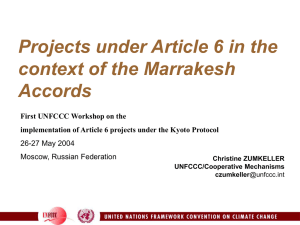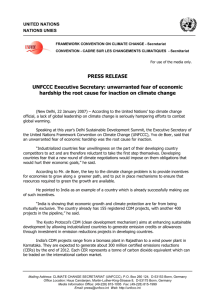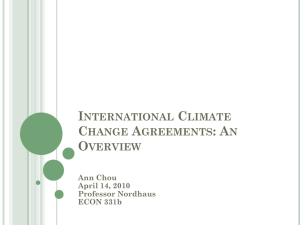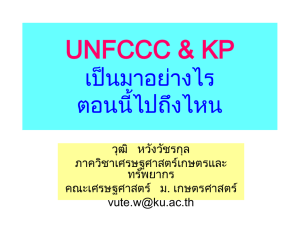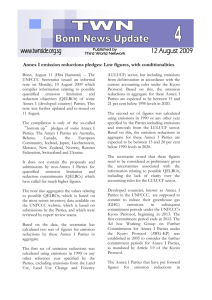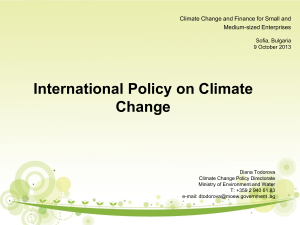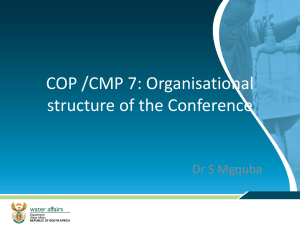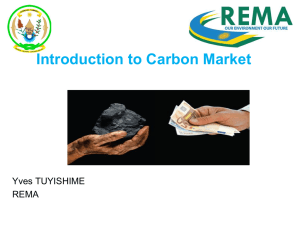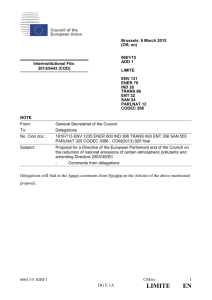Questions and Answers: Joint Implementation (JI)
advertisement
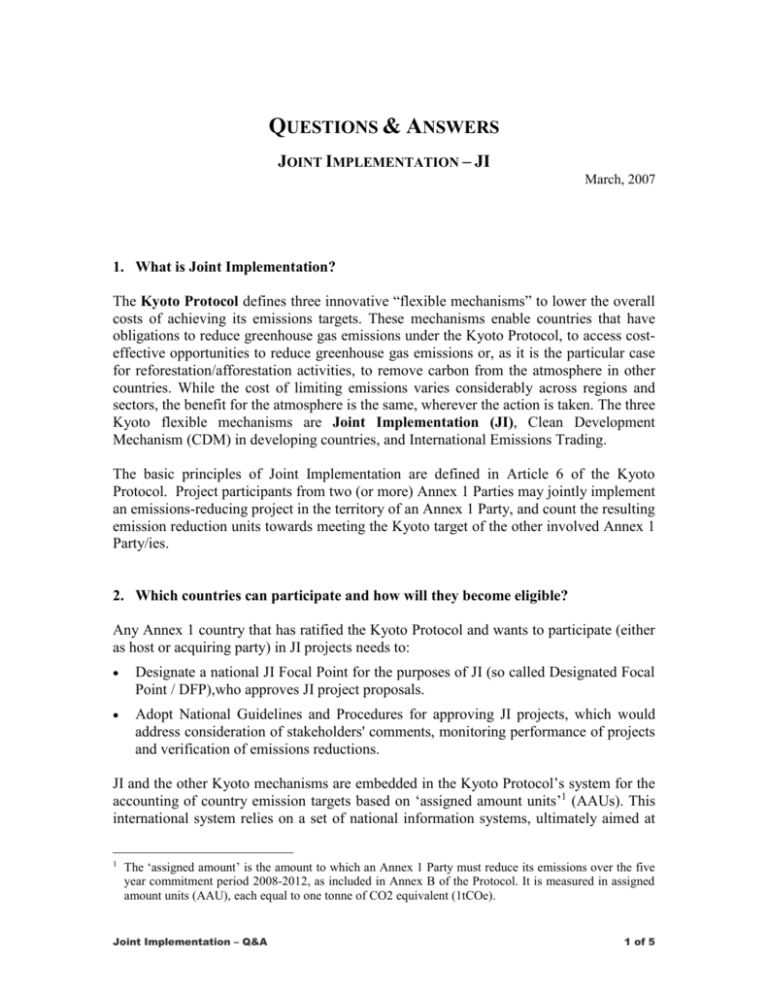
QUESTIONS & ANSWERS JOINT IMPLEMENTATION – JI March, 2007 1. What is Joint Implementation? The Kyoto Protocol defines three innovative “flexible mechanisms” to lower the overall costs of achieving its emissions targets. These mechanisms enable countries that have obligations to reduce greenhouse gas emissions under the Kyoto Protocol, to access costeffective opportunities to reduce greenhouse gas emissions or, as it is the particular case for reforestation/afforestation activities, to remove carbon from the atmosphere in other countries. While the cost of limiting emissions varies considerably across regions and sectors, the benefit for the atmosphere is the same, wherever the action is taken. The three Kyoto flexible mechanisms are Joint Implementation (JI), Clean Development Mechanism (CDM) in developing countries, and International Emissions Trading. The basic principles of Joint Implementation are defined in Article 6 of the Kyoto Protocol. Project participants from two (or more) Annex 1 Parties may jointly implement an emissions-reducing project in the territory of an Annex 1 Party, and count the resulting emission reduction units towards meeting the Kyoto target of the other involved Annex 1 Party/ies. 2. Which countries can participate and how will they become eligible? Any Annex 1 country that has ratified the Kyoto Protocol and wants to participate (either as host or acquiring party) in JI projects needs to: Designate a national JI Focal Point for the purposes of JI (so called Designated Focal Point / DFP),who approves JI project proposals. Adopt National Guidelines and Procedures for approving JI projects, which would address consideration of stakeholders' comments, monitoring performance of projects and verification of emissions reductions. JI and the other Kyoto mechanisms are embedded in the Kyoto Protocol’s system for the accounting of country emission targets based on ‘assigned amount units’1 (AAUs). This international system relies on a set of national information systems, ultimately aimed at 1 The ‘assigned amount’ is the amount to which an Annex 1 Party must reduce its emissions over the five year commitment period 2008-2012, as included in Annex B of the Protocol. It is measured in assigned amount units (AAU), each equal to one tonne of CO2 equivalent (1tCOe). Joint Implementation – Q&A 1 of 5 ensuring an accurate accounting of the country’s assigned amount. Hence, in order to safeguard the integrity of emission reduction transactions among Annex 1 countries, countries need to meet a set of eligibility requirements to be allowed to engage in transference and acquisition of ERUs generated in JI projects2. The six eligibility requirements are basically related to having in place the above referred information systems, and are outlined in relevant guidelines of the Kyoto Protocol. 3. What are the steps in the JI project cycle? A project developer that wants to implement an emission reductions project should follow the steps of the JI project cycle. This cycle begins with the preparation of the project design documents according to the JI guidance established by the JI Supervisory Committee. The project developer needs to demonstrate that the project will lead to the emission reductions that are additional to the situation without the project. At the next step, the Accredited Independent Entity (AIE) determines if the emission reductions were correctly estimated and if necessary procedures were established to monitor the project performance during its implementation. The project design document as well as the determination report of the AIE is then made available for public comments. After the necessary improvements and responses to the public comments, the final version of the project and its determination report are again open for public comment. At this stage, the JI Supervisory Committee will consider the quality of the project and unless any review is requested by the JI Supervisory Committee, after 45 days, the project automatically acquires a status of JI project. Project completion Preparation and review of the Project Determination by AIE • PDD forms established by JISC • Letter of Approval by host country • Baseline setting & Monitoring • Publication of PDD for 30 days Transfer of ERUs Eligibility requirements day 45 s da ys 15 Possible review by JISC Periodic verification by AIE Letter(s) of Approval by investing country Determination report by AIE Possible review by JISC During the implementation of the JI project, the Accredited Independent Entity intervenes to periodically verify the generated emission reductions at least until the end of the first commitment period (2012) of the Kyoto Protocol. Unless the JI Supervisory Committee questions the results of the verification, the host country may transfer the verified 2 Meeting the eligibility requirements affects a countries’ ability to be involved in transactions of ERUs at the relevant point of time. It does not prevent project participants to carry on JI projects. Joint Implementation – Q&A 2 of 5 emission reductions to the investing country according to the results of the verification report. 4. Who benefits from a JI project? The sale of emission reduction units provides an additional revenue stream for the project owners and developers. In many cases this can be equivalent to anywhere from 10% up to 40 % of the project investment costs. Moreover, the additional revenue stream from the sale of emission reductions can also increase the bankability of projects as carbon revenues can reduce perceived risks of commercial lending. Thus, carbon finance provides project developers with a tool for leveraging new private and public investment into climate-friendly projects. JI also enables the transfer of efficient technologies and best available practices to the host countries, thereby contributing to long term climate change mitigation as well as to sustainable development including typically reductions of local pollution. For investing countries, JI helps to meet their emission targets under the Kyoto Protocol in a cost effective way. Being an early-mover in the development of JI projects, the World Bank’s Carbon Funds have demonstrated numerous greenhouse gas mitigation options across sectors where carbon finance operations have served as a catalyst in investments in public/private projects - for example in renewable energy, energy efficiency, waste management and forest management. 5. Who is active in the JI market? The Netherlands, Denmark and Austria are currently among the most active buyers in JI projects, mainly through different governmental purchase programs or participation in carbon funds. From the sellers’ side, countries like Bulgaria, Czech Republic, Romania and Poland moved early on in promoting JI projects, while the potential ‘big suppliers’, Russia and Ukraine, have more recently started to engage in JI initiatives and are rapidly increasing the number of prospective JI projects. Most countries involved in JI have already established their national Designated Focal Points (DFP) in charge of JI project approval. As of February 2007, there were 155 JI projects submitted to independent entities for determination (i.e. their JI project design documents have been made publicly available). They are expected to generate greenhouse gas emission reductions of about 27 million tons of carbon dioxide equivalent per year. JI is currently still a small part of the global carbon market. During 2006, approximately 21 million tons of carbon dioxide equivalent were transacted under JI, whereas CDM volume was approximately 520 million tons. The number of JI projects under development is, however, rapidly increasing. Joint Implementation – Q&A 3 of 5 The estimated, average ERU price in 2006 was EUR 6.5 (USD.8.4), slightly below average prices of Certified Emission Reductions (CERs) generated by CDM projects. This price difference can be mostly attributed to perceived risks and uncertainties relating to JI governance at both the national and international level. # of JI projects Ru ss i Bu a Cz l ec ga h r Re ia pu bl ic Uk ra in e Ro m an ia Po la n Hu d ng ar Es y t Ne oni a w Ze la n Li th d ua ni a Sl ov ak ia G er m an y La tv ia 30 25 20 15 10 5 0 Annual ERUs from JI projects Fossil fuel switch 9% CH4 reduction & Cement & Coal mine/bed 12% HFCs, PFCs & N2O reduction 7% Afforestation & Reforestation 0% Renewables 23% Energy Efficiency 49% Status: As of February 2006 based on 155 published JI projects Source: UNEP/Risoe, ‘Overview of JI Host Parties and “investor countries’; 3rd UNFCCC Technical Workshop on JI and the World Bank. Joint Implementation – Q&A 4 of 5 6. Where can one find additional information on Joint Implementation? JI governance institutions: Official UNFCCC website on Joint Implementation, including information on JI Guidelines and further JISC guidance: www.unfccc.int/ji Links to designated National JI Focal Points, including information on reported National Guidelines: http://ji.unfccc.int/JI_Parties Links to accredited independent entities (AIEs): http://ji.unfccc.int/AIEs/draft_of_index.html JI project pipeline: sample projects, case studies, best practices Official JI project pipeline (projects submitted under JI Track 2 verification procedure): follow the submenus on http://ji.unfccc.int/JI_Projects/Verification World Bank’s JI project portfolio: www.carbonfinance.org, submenu: ‘projects’ JI market institutions / other carbon market intelligence: World Bank’s Carbon Finance Unit: www.carbonfinance.org References: UNFCCC Joint Implementation website at www.unfccc.int/ji WB Carbon Finance Unit website at www.carbonfinance.org WB staff presentations on ‘JI project cycle’ (Jane Ebinger) and ‘Baseline setting and monitoring under JI’ (Alexandrina Platonova-Oquab). ‘CDM project pipeline’ database, UNEP Risoe Centre. Available at www.cd4cdm.org. ‘Joint Implementation: Current Issues and Emerging Challenges’. OECD/IEA, October 2006. Joint Implementation – Q&A 5 of 5
